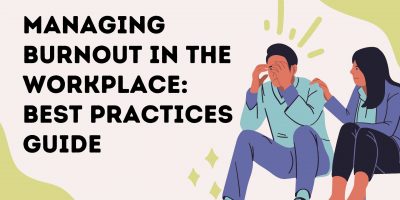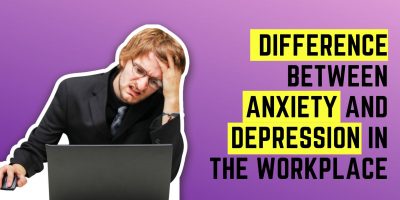
Managing Burnout in the Workplace: Best Practices Guide
As it can lead to absenteeism, decreased productivity, and increased turnover, managing burnout in the workplace is essential to keeping a healthy and productive workforce.

In 1968, American psychologist Wayne Oates popularized the term “workaholic,” a disorder masked as an addiction. He defined it simply as the overwhelming desire to work even when the person’s health, happiness, relationships, and social functioning are negatively impacted.
From that point on, workaholism as a phenomenon is deeply rooted in modern society, and interconnected with the “hustle” culture that emerged in the 70s.
This compulsive need to overperform professionally has outlasted many workplace trends.
Post-COVID, “hustling” has been losing traction over employee well-being. It wasn’t long ago when the new CEO of Twitter, Elon Musk, made headlines with his controversial demand for Twitter employees to become hardcore workers or quit. Unsurprisingly, hundreds resigned.
That’s because employee priorities have shifted. According to Microsoft’s 2022 Work Trend Index Annual Report, more than half of employees, or 53%, are more likely to prioritize health and wellness over work than before the pandemic.
But despite the work-life balance movement, excessive overworking is still a prevalent issue.
That’s because being a workaholic goes beyond a workplace trend. Some would describe it as an addiction since it bears more similarities with one than a cultural movement. One screening instrument, Bergen Work Addiction Scale (BWAS), measures it using the seven core elements of addiction:
Also, many studies over the years have shown that, as with other addictions, workaholism leads to considerable difficulties and a lasting impact on people’s relationships and health.
This Shortlister article explores theoretical and empirical evidence on the adverse effects of work addiction to understand how it influences people’s mental well-being, work engagement, and overall health.

Love it or hate it, work is an irreplaceable part of our lives.
Apart from the obvious benefits like a salary, a job is a great social instigator that provides a purpose and a sense of self. However, as with anything else, overdoing it can have a reverse effect. These people are what we’ve come to call workaholics.
There are many ways to explain what a workaholic is—the most superficial portrayal is someone who can’t stop working.
However, many complex psychological aspects go into defining such behavior. For example, psychologist Wayne Oates was the first to explore workaholism as a genuine concept in the 70s. He also brought up compulsiveness as one of the main characteristics. In its 1971 paper “Confessions of a Workaholic: The Facts about Work Addiction,” Oates defines workaholism as “compulsion or the uncontrollable need to work incessantly.“
Since then, there have been many altercations to the workaholic meaning.
Some connect it to working long hours and showing high work investment. Others analyze it as an addiction and research dysfunctional components like work obsessiveness and compulsiveness and neglecting other aspects of life.
Throughout history, some researchers considered work addiction as a positive attribute even. Many still support this premise. In fact, some of the biggest entrepreneurial names, like Musk or Gates, preach about the benefits of hustle culture. They ascribe their success to working endless hours and having no rest days. Thus, the conclusion would be that work-addicted people should be perceived as hard-working and ambitious.
So, is it a good or a bad thing?
With numerous studies to back it up, many nowadays see work addiction for what it truly is—a destructive urge to overwork oneself that affects people’s lives in and outside the workplace.
Workaholics tend to only think and talk about their work since they can’t detach from it in their personal life. They usually obsess over their job responsibilities outside of working hours when on sick leave or vacation.
From an employer’s standpoint, despite what one might assume, work addiction is bad for work engagement.
For example, “The Productivity of Working Hours” report shows that workers who put in 70 hours weren’t more productive than those working 56 hours. Even more alarming is that other research papers also indicate that obsessive work can lead to burnout and serious health issues. A study by the Lancet on long working hours reveals that employees who work more have a higher risk of a stroke.
Considering everything, it’s vital to catch on to the symptoms of a workaholic before it becomes a menace to their and the company’s well-being.
It’s easy to recognize a workaholic.
Usually, it’s the person in the friend group that constantly cancels plans due to work and the one that can’t stop talking about it. Or it’s the colleague who puts in the most hours, even when it’s not needed.
According to Healthline Media, workaholic symptoms are:
Apart from these, there are other physical or behavioral indications of work addiction:
Workaholism, as a term, had its first appearance in 1947 as a portmanteau between “work” and “alcoholic.” According to the Oxford English Dictionary, the Toronto Daily Star newspaper used it as an allusion to Alcoholics Anonymous.
The newspaper excerpt cited: “If you are cursed with an unconquerable craving for work, call Workaholics Synonymous, and a reformed worker will aid you back to happy idleness.“
Years later, in the 70s, Wayne Oates popularized the term when he initiated the discussion on compulsive work. Seeing how it resembles an addiction, the buzzword quickly found its place in colloquial language. But there was never entirely an agreement on whether it represents a positive or a negative thing.
The report “Workaholism: An overview and current status of the research” sums up decades worth of research into understanding this construct.
Namely, a 1980 definition by Machlowitz describes workaholics as employees who work more than they need to. Mosier, in 1983, narrowed it down to working more than 50 hours. But these were all too broad depictions. More contemporary interpretations dive deeper into the cause and describe excessive overwork as a “continual pattern of high work investment, long working hours, work beyond expectations, and an all-consuming obsession with work.“
Another more recent research narrows it down to two main components:
Despite being popularized half a century ago, to this day, the workaholism construct still lacks conceptual and empirical clarity.

Several characteristics are closely related to workaholics.
Unlike engaged workers who are predominantly happy with their job, work addicts experience negative feelings such as stress, panic, guilt, boredom, or loneliness.
In fact, the “Examining the Antecedents and Consequences of Workaholism” report reveals that the effect of work addition on life satisfaction was significantly mediated by leisure, boredom, and loneliness.
The study also examines one common characteristic of workaholics – their perfectionistic tendency. Namely, perfectionism and negative affect significantly predicted workaholism scores. Additionally, researchers found that perfectionism directly predicted loneliness, leading to lower life satisfaction. Unsurprisingly, the report concludes that excessive work equals low life satisfaction.
Another study by the Department of Psychosocial Science at the University of Bergen (UiB) in Norway identified three additional personality traits intricately connected to workaholics:
The results further indicated that younger workers are more addicted to working than their elder colleagues. Also, parents were more likely to be affected than childless employees.
Workaholic tendencies and their consequences are measurable. In fact, the severity of the condition and its effect on organizations and employees imposes a need to measure it effectively.
Over the past two decades, many screening instruments have been developed and used to identify workaholics. They each focus on distinct factors and have a separate way of calculating the scores. Some of the most successful and widely used to this day are:
Bryan E. Robinson‘s Work Addiction Risk Test (WART) was the first to measure the hustle culture’s unhealthy characteristics. To this day, the assessment is still relatable.
Although there could be variations, the questionnaire typically consists of 25 items distributed between five factors:
Participants can choose their answer from a four-point score, or one – never true to four – always true. The score ranges from one to 100, and the more points a person has, the more likely they are to be addicted to their work. Namely, scores from 25 to 56 indicate “low risk of work addiction,” from 57 to 66 are “medium risk of work addiction,” and from 67 to 100, “high risk of work addiction.”
The Workaholism Battery (WorkBAT) test by Spence and Robbins came only a few years after WART. Nonetheless, this one is probably the most well-known of all approaches to measuring workaholic tendencies.
Like WART, the WorkBAT questionnaire consists of 25 items. However, it has a scoring system with one-to-five score answers ranging from strongly disagree to strongly agree. Also, the items are distributed over three subscales:
According to the results, workaholics score above the mean on work involvement and drive but below par for work enjoyment. In contrast, work enthusiasts who are not compulsively looking at their job scored high results of pleasure and involvement in work but scored below the mean on the work drive factor.
Overall, the results revealed six types of workers:
A more recent scale for assessing excessive overwork is the 2009 Dutch Work Addiction Scale (DUWAS) by Schaufeli, Shimazu, and Taris.
The scoring system is based on a four-point scale with items ranging from one point for “totally disagree” to four points for “totally agree.”
A broad definition characterizes a workaholic as someone who works compulsively and excessively. Thus, the DUWAS approach focuses on two subscales:
The questions combine the compulsive tendencies factor in WART and the work drive factor from WorkBAT. There are four additional questions in the assessment on overwork and working hours.
Finally, the Bergen Work Addiction Scale (BWAS) estimates excessive and compulsive work a bit differently. Unlike the other three, this scale measures excessive overwork as an addiction, thus using the seven core elements of addiction: salience, mood modification, tolerance, withdrawal, conflict, relapse, and problems.
For each factor, there are two items or 14 total. The measuring system is a five-point Likert scale where one means never, and five means always.

Work addiction and work engagement are two vastly different concepts. While one is related to excessive overworking, the other often refers to a positive and fulfilling employee experience.
Engaged workers, unlike workaholics, have a work-life balance and are happily involved with job responsibilities without feeling compelled to do them. Also, while both share a high level of activation as a mutual characteristic, their drive to work stems from a different place.
For workaholics, it’s an irrepressible desire anchored in guilt and self-afflicted pressure. In contrast, for engaged workers, it comes from a place of enjoyment and satisfaction.
A research document for the Journal of Vocational Behavior published on HAL explores the correlation between excessive overwork and work engagement through three independent studies. Each uses different methodologies to document the relations between workaholism, work engagement, and work outcomes, or interaction effects, a person-centered approach and a hybrid mixture regression approach.
The main findings were the following:
To tackle the issue of excessive overwork, the researchers summarize the findings into the following workplace recommendations:
Many reports suggest that excessive overwork can lead to serious health issues. In fact, in Japan, it’s such a severe societal problem that they call this phenomenon karōshi, or death from overwork.
But, this is not exclusive to Japan.
A research paper, “Exploring the Link between Work Addiction Risk and Health-Related Outcomes Using Job-Demand-Control Model,” reveals excessive overwork can lead to depression.
Namely, employees with higher work addiction risk were twice as likely to develop depression than those with low risk. Also, their sleep quality was lower, and they were more likely to exhibit significant stress levels and poorer well-being.
Harvard Business Review issued research looking into the health implications of overworking. The study consisted of two stages, a survey with questions on the participants’ work addiction tendencies and a health screening. It also distinguishes between people who work longer but don’t obsess about their work and those that do, regardless of how many hours they put in.
Results indicate that those who worked longer hours were not at risk of health issues. However, workaholics were.
In fact, they had more health complaints, sleep problems, emotional exhaustion, depression symptoms, and an increased Risk for Metabolic Syndrome (RMS). The latter indicates a person’s risk of developing cardiovascular diseases and diabetes.
This is evidence enough that, despite attempts to popularize overworking, doing such a thing can have many adverse long-term consequences for the employees.
Studies have shown the health impact of excessive overworking. However, they don’t entirely portray the consequences it can have on a person’s mental and social well-being in the workplace and beyond this environment.
For example, workaholics are unpleasant to be around and don’t function well in teams due to their perfectionistic tendencies. Due to the stress they feel, they can also be unproductive.
But it’s even worse when work takes over their social and family life.
Work addicts who don’t treat this addiction eventually manage to isolate themselves entirely from the outside world. Being “married to their work” can have profound implications, resulting in losing touch with friends or ruining the family dynamic.
Overall, the mental toll of workaholism is harsh. So, any benefit it might have, like work success, falls short before the long-term negative implications that come with it.

Work takes up a significant amount of our time. For some people, the dedication they put into their work brings a sense of accomplishment and pleasure. So, it’s easy to see how hustling can be perceived as a positive thing.
However, workaholism is not a badge of honor or an indication of someone’s societal worth.
It’s a complicated issue with much more complex implications for a person’s professional and personal life. As such, it requires special attention, especially from employers whose responsibility is to prevent this behavior rather than to reward it.
Disclosure: Some of the products featured in this blog post may come from our partners who compensate us. This might influence the selection of products we feature and their placement and presentation on the page. However, it does not impact our evaluations; our opinions are our own. The information provided in this post is for general informational purposes only.
Content Writer at Shortlister
Browse our curated list of vendors to find the best solution for your needs.
Subscribe to our newsletter for the latest trends, expert tips, and workplace insights!

As it can lead to absenteeism, decreased productivity, and increased turnover, managing burnout in the workplace is essential to keeping a healthy and productive workforce.

EAP use is on the rise, and rightfully so. As these programs find their way into the workplace, we explore their many benefits, the range of services available, and how employees can take full advantage of them.

Loneliness can be a serious problem affecting not only employees’ mental health but also the bottom line for businesses. What are the tell-tale signs of workplace loneliness, and what can employers and organizations do to reduce or mitigate it?

Dive into the distinctions between anxiety and depression, their impact on the workplace, and how employers can recognize and address them.
Used by most of the top employee benefits consultants in the US, Shortlister is where you can find, research and select HR and benefits vendors for your clients.
Shortlister helps you reach your ideal prospects. Claim your free account to control your message and receive employer, consultant and health plan leads.